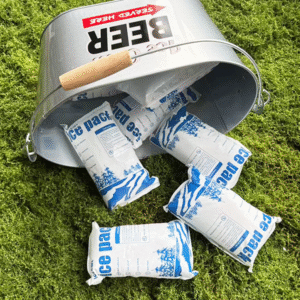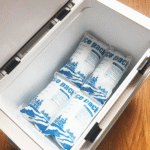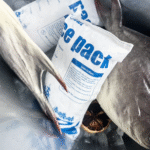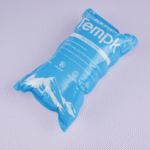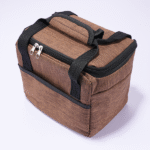Paquetes de hielo seco criogénicos: ¿Cómo mantienen los envíos ultrafríos??
El transporte de mercancías sensibles a la temperatura en un mundo de cadenas de suministro globales requiere soluciones de refrigeración que vayan más allá del hielo ordinario.. Paquetes de hielo seco criogénicos—productos de dióxido de carbono sólido diseñados para envíos ultrafríos—mantienen los productos a –78,5°C sin dejar agua derretida y son indispensables para las vacunas, muestras de biotecnología, alimentos gourmet y procesos industriales. La demanda de hielo seco ha aumentado aproximadamente un 5% anual, mientras que el suministro de dióxido de carbono sólo ha crecido alrededor del 0,5%, impulsando la volatilidad de los precios y las limitaciones de la oferta. Esta guía explica qué son las bolsas de hielo seco criogénicas., how they work, cómo elegirlos y utilizarlos de forma segura y eficiente, y ¿qué innovaciones están remodelando este campo en 2025. Al final, sabrás cómo estos packs pueden proteger tus productos y tu negocio.
¿Qué son las bolsas de hielo seco criogénicas y por qué son esenciales para la logística de la cadena de frío??
¿En qué se diferencian los paquetes de hielo seco criogénico a base de pellets y a base de láminas y cuál se adapta a su envío??
¿Cómo se pueden empacar bolsas de hielo seco de manera segura y cumplir con las regulaciones IATA y DOT??
¿Qué fórmulas te ayudan a calcular la cantidad correcta de hielo seco?, y ¿cómo se minimiza la sublimación??
¿Qué innovaciones y tendencias del mercado darán forma a las bolsas de hielo seco criogénicas en 2025 y más allá?
¿Qué son las bolsas de hielo seco criogénicas y cómo funcionan??
Las bolsas de hielo seco criogénicas son agentes refrigerantes elaborados a partir de dióxido de carbono sólido. (Co₂) Diseñado para mantener temperaturas por debajo de –78,5 °C durante períodos prolongados.. A diferencia del hielo del agua, hielo seco Susilimaciones—pasa directamente de sólido a gas, por lo que no deja residuos líquidos. Esto lo hace ideal para enviar productos que no se pueden mojar ni calentar., como las vacunas, muestras biológicas y alimentos delicados. Porque el CO₂ no es tóxico, El hielo seco es seguro para aplicaciones alimentarias y médicas.. Los paquetes criogénicos vienen en dos formatos principales:bandear y empacar hojas—cada uno optimizado para diferentes situaciones.
Cómo las bolsas de hielo seco criogénicas mantienen las cosas congeladas
Las bolsas de hielo seco criogénicas mantienen los productos ultrafríos al Absorber calor y liberar gas CO₂.. Los pellets (pequeñas piezas cilíndricas de 3 a 16 mm de diámetro) tienen una gran superficie y proporcionan un enfriamiento rápido., temperaturas que caen rápidamente a –78,5°C. Hojas de paquete, por el contrario, encerrar bolitas o “nieve” de CO₂ en celdas flexibles, liberando lentamente aire frío durante hasta 72 horas. Porque el hielo seco no se derrite, Evita los problemas de agua derretida y moho asociados con el hielo común..
Pellets vs.. Hojas de paquete: ¿Qué formato se adapta a su envío??
El hielo seco viene en varios formatos.. El elección entre pellets y hojas de embalaje Depende de qué tan rápido necesite enfriar su producto., cuánto tiempo debe permanecer frío y qué tan fácil debe ser su manipulación:
| Método de enfriamiento | Rango de temperatura | Duración típica | Aplicación ideal | Lo que significa para ti |
| Pellets de hielo seco | –78,5°C | 24–48 horas | Envío ultrafrío de vacunas y muestras biotecnológicas; enfriamiento rápido para limpieza criogénica | Proporciona congelación instantánea y control preciso de la temperatura, pero se sublima rápidamente.; Requiere EPP y ventilación. |
| Hojas de paquete de hielo seco | –40°C a –60°C | 36–72 horas | Carne congelada, mariscos, envíos de alimentos especiales y biotecnología a temperatura media | Ofrece enfriamiento gradual y duración extendida.; reutilizable y más fácil de manejar; reduce la exposición al CO₂ |
| Paquetes de gel | 0 °C a –20°C | 12–24 horas | Alimentos y productos farmacéuticos perecederos que requieren temperaturas cercanas al punto de congelación. | Asequible y reutilizable, pero no lo suficientemente frío para productos criogénicos. |
| Materiales de cambio de fase (PCM) | Personalizable | 24–96 horas | Kits y diagnósticos biofarmacéuticos que necesitan bandas de temperatura precisas | Mantiene temperaturas estables pero requiere una selección precisa del punto de transición de fase. |
Bandear ofrecer refrigeración instantánea. Son de un solo uso y pueden provocar congelación., por lo que necesitas guantes y gafas aislantes al manipularlos. Los pellets suelen durar entre 24 y 48 horas, según el aislamiento y la temperatura ambiente.. Hojas de paquete Son paneles flexibles que incorporan bolitas de hielo seco dentro de bolsillos duraderos.; ellos proporcionan enfriamiento constante y prolongado hasta 72 horas, Minimiza la exposición al CO₂ y se puede volver a congelar y reutilizar.. Son ideales para productos que necesitan frío de gama media. (–20°C a –60°C) o envíos que duren más de dos días.
Consejos prácticos y sugerencias
Envío ultra frío (–70°C y menos): Utilice paquetes a base de pellets con transportadores aislados al vacío.. Vacunas y biológicos a menudo requieren condiciones ultra frías; La combinación de gránulos densos con un aislamiento de alto rendimiento puede mantener las vacunas estables durante 48 horas y reducir el riesgo de deterioro en un 40 %..
Tránsito medio frío o prolongado: Elija hojas de embalaje para carne congelada o alimentos especiales que requieran de –29 °C a –40 °C. Mantienen los productos congelados sin residuos líquidos y pueden reutilizarse para envíos recurrentes..
Enfriamiento híbrido: Combine pellets y hojas de embalaje con materiales de cambio de fase. (PCM) Para obtener un enfriamiento inicial rápido y estabilidad a largo plazo.. Una configuración híbrida típica coloca capas de pellets en la parte inferior., empaquete las hojas alrededor del producto y el PCM en la parte superior; esto puede ampliar el tiempo de espera en un 25 % y reducir el consumo de hielo seco en un 18 %.
Ejemplo del mundo real: Una empresa de biotecnología que envía vacunas de ARNm utiliza un sistema híbrido: 8 kg de gránulos de hielo seco en el fondo de un contenedor aislado al vacío de 30 litros, dos capas de hielo seco de 24 celdas que rodean los viales y los paquetes de PCM en la parte superior. Esta configuración mantiene temperaturas por debajo de –70 °C durante 60 horas y reduce el uso de hielo seco en aproximadamente un 20 % en comparación con los pellets solos..
Cómo empacar bolsas de hielo seco criogénicas de forma segura y cumplir con las regulaciones?
La seguridad es primordial cuando se trabaja con bolsas de hielo seco criogénicas. El CO₂ sólido plantea tres peligros principales:asfixia, congelación, y explosión—si se maneja incorrectamente. Las regulaciones internacionales también exigen un embalaje y etiquetado adecuados..
Principios clave de seguridad
Manipule siempre el hielo seco en un área bien ventilada y use equipo de protección.. El hielo seco se sublima en gas co₂, que puede desplazar el oxígeno y causar asfixia en espacios reducidos. El contacto con temperaturas criogénicas puede provocar quemaduras graves en la piel.; usar guantes aislantes, gafas y protectores faciales. El hielo seco tiene una relación de expansión de 1:554, así que nunca lo selles en un recipiente hermético; La acumulación de presión puede causar una explosión..
Embalaje & Requisitos de etiquetado
Agencias reguladoras como la Asociación Internacional de Transporte Aéreo (IATA) y el A NOSOTROS. Departamento de Transporte (PUNTO) clasificar el hielo seco como Material Peligroso porque libera gas CO₂. Las siguientes pautas garantizan el cumplimiento y la seguridad.:
Use contenedores aislados: Utilice siempre una caja bien aislada o un envío con aislamiento al vacío para retardar la sublimación y proteger su producto..
Contenedores de condición previa: Preenfriar el recipiente para reducir el choque térmico.. El preacondicionamiento puede reducir la sublimación hasta en 15 De %.
Técnica de capas: Coloca hielo seco en el fondo., agregar un búfer (cartón o espuma), luego coloque su producto y rellene los huecos con material acolchado para evitar bolsas de aire caliente.. Agregue hojas de paquete adicionales o pellets encima; el aire frío se hunde y envuelve el producto.
Proporcionar ventilación: No selle el hielo seco en envases herméticos; asegúrese de que las rejillas de ventilación permitan que escape el gas CO₂.
Etiquetar correctamente: Marque los paquetes con “hielo seco” o “dióxido de carbono”., Sólido” y Y 1845 junto con el peso neto del hielo seco. Colocar un Etiqueta de materiales peligrosos clase 9 cuando se envía por aire.
Respete los límites de peso: Límite de las regulaciones IATA 2.5 kg de hielo seco por bulto en aviones de pasajeros y hasta 200kg en vuelos de carga.
Capacitación: Sólo personas capacitadas deben manipular envíos de hielo seco.. Mantenga información de respuesta de emergencia y un número de contacto las 24 horas en los documentos de envío..
Proceso de embalaje paso a paso
El siguiente procedimiento garantiza un embalaje seguro y conforme a las normas de bolsas de hielo seco criogénicas.:
Preparación: Si usa hojas de paquete reutilizables, hidratarlos sumergiéndolos en agua antes de congelarlos para que las células se activen adecuadamente. Congelar hojas planas.
Pre-enfriamiento: Coloque el recipiente aislado en un congelador o enfríelo previamente con bolsas de hielo en gel durante varias horas..
Capa inferior: Agregue la cantidad requerida de pellets o una hoja de embalaje en el fondo del contenedor..
Capa de búfer: Coloque una capa de cartón o espuma sobre el hielo seco para evitar el contacto directo con su producto y evitar quemaduras por congelación..
Colocación del producto: Carga tus artículos, llenar los huecos con material acolchado como plástico de burbujas o inserciones de espuma.
Capa superior: Agregue más hojas o pellets encima para mantener una temperatura uniforme.
Ventilación & Cierre: Asegúrese de que el contenedor esté ventilado.; Asegure la tapa sin sellarla herméticamente..
Etiqueta & Documento: Adjuntar etiquetas de peligro, tenga en cuenta el peso del hielo seco, e incluir información de contacto de emergencia.
| Preocupación por la seguridad | Riesgo & Regulación | Implicación práctica |
| Asfixia | El CO₂ desplaza al oxígeno; manejar en áreas ventiladas | La ventilación evita la asfixia.; nunca trabaje en espacios cerrados |
| Congelación | Peligro de contacto a –79°C | Use guantes y gafas aislantes para evitar quemaduras en la piel. |
| Explosión | Relación de expansión del gas de 1:554 | No selle hielo seco en recipientes herméticos; incluir orificios de ventilación |
| Límites de peso reglamentarios | 2.5 kg por vuelo de pasajero; 200 kg por vuelo de carga | Planifique los envíos en consecuencia y elija vuelos de carga para grandes volúmenes |
| Etiquetado | Debe mostrar “Hielo seco,”UN1845 y peso neto | Asegúrese de que los paquetes estén correctamente marcados para evitar retrasos o multas. |
Ejemplo del mundo real: Un laboratorio que enviaba muestras genéticas olvidó ventilar su refrigerador; como el hielo seco se sublima, La presión se acumuló y rompió la tapa durante el transporte.. Un plan de embalaje conforme con orificios de ventilación., Las capas de protección y el etiquetado correcto habrían evitado el incidente..
¿Cuántas bolsas de hielo seco criogénicas necesita?? Fórmulas de dimensionamiento y consejos prácticos
Obtener la cantidad correcta garantiza que su envío permanezca congelado sin desperdicio. Muy poco hielo seco provoca picos de temperatura; demasiado añade costos y riesgos de seguridad. Utilice las siguientes pautas para calcular la cantidad correcta.
Fórmulas de tamaño
Regla general de los pellets: Asignar 5–10 kg de hielo seco por período de 24 horas por 100 litros de volumen aislado. La cantidad exacta depende de la calidad del aislamiento y de las condiciones ambientales..
Duración de la hoja del paquete: A 24La capa de hielo seco celular proporciona aproximadamente entre 8 y 12 horas de enfriamiento.. Varias hojas pueden extender el tiempo de espera a 72 horas.
| Volumen del contenedor | Peso recomendado del pellet | Cantidad de hojas por paquete | Tiempo de espera esperado |
| 10 L | 0.75–1kg | 1 hoja | ≈12 horas |
| 20 L | 1.5–2,0 kg | 2 hojas | ≈24 horas |
| 30 L | 2.5–3,0 kg | 3–4 hojas | ≈36 horas |
| 40 L | 4.0–5,0 kg | 4–5 hojas | ≈48–72 horas |
El preenfriamiento reduce la sublimación hasta en un 15%. Llene siempre los espacios vacíos con material de estiba para minimizar la transferencia de calor.. Para envíos superiores a 72 horas, combine hielo seco con paquetes de PCM o elija criotransportadores especializados que puedan mantener temperaturas ultrabajas durante días.
Consejos prácticos para dimensionar
Hacer coincidir la duración con el tiempo de tránsito: Calcule cuánto tiempo estará en tránsito su envío, incluyendo posibles retrasos. Agregue un margen de seguridad para evitar quedarse sin capacidad de enfriamiento.
Considere la calidad del aislamiento: Un mejor aislamiento reduce la sublimación. Invertir en contenedores de alto rendimiento puede reducir el uso de hielo seco y reducir los costos.
Cuenta de temperatura externa: Los envíos de verano requieren más hielo seco que los de invierno porque el calor externo acelera la sublimación.
Utilice sistemas híbridos: Para envíos de larga distancia, combine hielo seco con PCM para prolongar la duración y reducir el consumo de CO₂ en aproximadamente un 18%.
Crear una herramienta u hoja de trabajo: Una calculadora interactiva en su sitio web permite a los clientes ingresar el volumen de envío, duración y calidad del aislamiento; Genera el peso recomendado de pellets y el número de hojas.. Esto reduce las conjeturas y mejora la participación del usuario..
Ejemplo del mundo real: Un exportador de productos del mar que envía 20 kg de atún congelado al extranjero empaca una hielera aislada de 40 litros con 5 kg de gránulos de hielo seco., 4 Hojas de embalaje y revestimientos aislados al vacío.. El envío llega después de 48 horas a –29°C, Preservar textura y sabor, y utiliza un 15 % menos de hielo seco que envíos anteriores al enfriar previamente el enfriador y llenar los huecos.
¿Cuáles son las últimas tendencias que dan forma a las bolsas de hielo seco criogénicas? 2025?
La industria de las bolsas de hielo seco criogénicas está evolucionando rápidamente en respuesta a las limitaciones de suministro, Demandas de sostenibilidad e innovación tecnológica.. Comprender estas tendencias le ayuda a tomar decisiones informadas y mantenerse competitivo.
Dinámica del mercado y presiones de oferta
La demanda de hielo seco está en auge: el consumo mundial está aumentando aproximadamente 5 % por año mientras que el suministro de dióxido de carbono sólo crece 0.5 De %, provocando escaseces periódicas y aumentos de precios de hasta 300 De %. El mercado mundial de hielo seco estaba valorado en $1.54 mil millones en 2024 y se prevé que alcance $2.73 mil millones por 2032 (7.4 % tasa de crecimiento anual compuesta). La escasez de oferta está impulsando a los fabricantes a construir centros de producción localizados e invertir en la captura de CO₂ in situ..
Formato & Consideraciones de rendimiento
Elegir el formato de hielo seco adecuado es fundamental. Bloques grandes se subliman lentamente y son ideales para el transporte a granel. Bandear proporciona un enfriamiento rápido pero se vaporiza más rápido. rodajas finas establecer un equilibrio, encajar perfectamente en el embalaje y reducir los huecos. Diseño adecuado del contenedor: utilizando aislamiento de alto rendimiento, Preacondicionamiento y minimización del espacio vacío: reduce la sublimación a 3–8% por día. Errores como dejar bolsillos calientes o una ventilación deficiente pueden comprometer la integridad del producto.
Innovaciones de sostenibilidad
La sostenibilidad es un valor fundamental en 2025. La cadena mundial de frío alimentario representa alrededor del 2% de las emisiones globales de CO₂. Para reducir el impacto ambiental del hielo seco, Los actores de la industria están adoptando varias innovaciones.:
Captura de CO₂ & Recuperación: La captura de dióxido de carbono de la fermentación del bioetanol o de procesos industriales crea fuentes renovables., fuentes circulares de hielo seco.
Hojas de paquete reutilizables: Las capas de hielo seco duraderas se pueden volver a congelar varias veces, Reducir el desperdicio y el costo..
Paquetes híbridos: La integración de PCM y aislamiento de alto rendimiento reduce el uso de CO₂ en un 18 % y extiende los tiempos de espera.
Sensores inteligentes & Seguimiento de IoT: El monitoreo en tiempo real de la temperatura y los niveles de CO₂ ayuda a ajustar el enfriamiento y minimizar el desperdicio. Según análisis de la industria, Los sistemas de seguimiento en tiempo real reducen el deterioro y garantizan el cumplimiento normativo..
Biodegradable & Embalaje reciclable: Las soluciones de embalaje sostenibles están ganando terreno para minimizar los residuos y cumplir con las normativas medioambientales..
Tecnológico & Tendencias del mercado
Automatización & Robótica: Acerca de 80 % de almacenes carecen de automatización. Sistemas automatizados de almacenamiento y recuperación., La robótica y la inteligencia artificial se utilizan cada vez más en el almacenamiento en frío para mejorar la eficiencia y reducir los costos laborales..
Visibilidad de extremo a extremo: La adopción generalizada de dispositivos habilitados para IoT proporciona información en tiempo real sobre la temperatura, ubicación y humedad. El seguimiento en tiempo real optimiza las rutas y reduce el deterioro.
Modernización de la infraestructura: Mejora del aislamiento, Los sistemas de refrigeración y la eficiencia energética son esenciales para reducir los costos de energía y cumplir con los objetivos de sostenibilidad..
Crecimiento farmacéutico: Aproximadamente 20 % de nuevos fármacos son terapias genéticas y celulares Requiere un control estricto de la temperatura., y se prevé que el mercado de la cadena de frío farmacéutica alcance los 1.454 millones de dólares en 2029.
Logística Sostenible: Se prevé que la logística de la cadena de frío de alimentos alcance $86.67 mil millones en América del Norte 2025. Las prácticas sostenibles reducen el desperdicio de alimentos y se alinean con las demandas de los consumidores..
Implicaciones prácticas de las tendencias
Prepárese para la volatilidad: Consiga contratos de suministro de hielo seco a largo plazo o invierta en unidades peletizadoras localizadas para evitar picos de precios..
Invertir en sostenibilidad: Elija proveedores que capturen CO₂ de fuentes renovables y adopten hojas de embalaje reutilizables.
Adopte la IoT: Incorpore sensores de monitoreo inteligentes y rastree los envíos para garantizar el cumplimiento, Minimizar el deterioro y brindar transparencia a los clientes..
Plan de refrigeración híbrida: Combine hielo seco con PCM para reducir el consumo y la huella de carbono manteniendo la confiabilidad.
Ejemplo del mundo real: Un distribuidor farmacéutico implementó sensores habilitados para IoT en transportistas criogénicos. El sistema monitoreó la temperatura y los niveles de CO₂ cada 10 minutos y alertó al personal cuando se aceleró la sublimación.. Ajustando la cantidad de hojas de paquete en tiempo real, redujeron las excursiones del producto en un 30% y ahorraron un 18% en el consumo de hielo seco.
Preguntas frecuentes
Q1: ¿Pueden las bolsas de hielo seco criogénico mantener los envíos de vacunas por debajo de –70°C??
Sí. Los pellets colocados en contenedores aislados al vacío pueden mantener temperaturas de alrededor de –78,5 °C durante 24 a 48 horas.. Combine pellets con láminas de embalaje y PCM en un paquete híbrido para extender los tiempos de espera a 60 horas o más..
Q2: ¿Son reutilizables las bolsas de hielo seco criogénicas??
Los packs de pellets son de un solo uso debido al riesgo de sublimación y contaminación.. Hojas de paquete, sin embargo, están diseñados para múltiples usos; guardan los gránulos en bolsillos duraderos y se pueden volver a congelar y reutilizar., reduciendo el desperdicio y el costo.
Q3: ¿Qué precauciones de seguridad debo tomar al manipular bolsas de hielo seco criogénicas??
Trabaje siempre en un área bien ventilada., use guantes y gafas aislantes, y evitar envases herméticos. Etiquete los paquetes con “Hielo seco,”UN1845 y peso neto, y respetar los límites de peso de la IATA: 2,5 kg para vuelos de pasajeros y hasta 200 kg para carga.
Q4: ¿Cómo se comparan las bolsas de hielo seco criogénicas con las de gel o PCM??
Las bolsas de hielo seco mantienen temperaturas mucho más frías (–78,5°C para pellets; –40°C a –60°C para láminas) y no deja residuos líquidos. Los paquetes de gel son adecuados para temperaturas de 0 °C a –20 °C y son más baratos y reutilizables.. Los paquetes PCM ofrecen bandas de temperatura personalizables y una mayor duración, pero es posible que no alcancen temperaturas ultrafrías.
Q5: ¿Cómo calculo la cantidad adecuada de hielo seco para mi envío??
Utilice la regla general de 5–10 kg de pellets cada 24 horas por 100 litros de volumen. Para hojas de paquete, una hoja de 24 celdas proporciona aproximadamente 8–12 horas de enfriamiento; ampliar según la duración y el tamaño del contenedor. Enfríe previamente el recipiente y rellene los huecos con material de estiba para reducir la sublimación hasta en un 15 %..
Resumen y recomendaciones
Las bolsas de hielo seco criogénicas desempeñan un papel vital en las cadenas de frío globales. Paquetes de pellets entregar rápido, enfriamiento ultrafrío a –78,5°C y son ideales para vacunas, limpieza biológica y criogénica. Hojas de paquete Proporciona refrigeración prolongada de –40 °C a –60 °C, son reutilizables y más seguros de manipular, haciéndolos adecuados para envíos de alimentos y biotecnología a temperatura media. embalaje adecuado, El etiquetado y la ventilación son esenciales para evitar riesgos como la asfixia., congelación y explosiones. Utilice fórmulas de tamaño (de 5 a 10 kg de hielo seco cada 24 horas por 100 litros de volumen) y acondicione previamente los contenedores para minimizar la sublimación.. Adopte paquetes híbridos con PCM para ampliar los tiempos de espera y reducir el uso de CO₂.
Pasos procesables
Evalúe su envío: Identificar los requisitos de temperatura. (p.ej., –78,5°C para vacunas o –20°C para alimentos) y duración del tránsito.
Elija el formato correcto: Utilice pellets para tránsitos ultrafríos o cortos.; Elija hojas de embalaje para duraciones más largas y logística reutilizable.
Calcular cantidad: Aplique las fórmulas de tamaño para determinar cuántos paquetes necesita; use una calculadora interactiva para mayor precisión.
Empacar con seguridad: Contenedores de preenfriamiento, colocar capas de hielo seco correctamente, proporcionar ventilación y etiquetar los paquetes con UN1845 y peso neto.
Monitor & Innovar: Incorpore sensores IoT para rastrear la temperatura y los niveles de CO₂ en tiempo real. Explorar hojas reutilizables, paquetes híbridos y fuentes renovables de CO₂ para cumplir los objetivos de sostenibilidad.
Planifique el futuro: Manténgase informado sobre la dinámica del mercado, volatilidad de precios y tecnologías emergentes como la automatización, IA y seguimiento en tiempo real para mantener la competitividad.
Acerca de Tempk
Templ es un proveedor global de soluciones de embalaje para la cadena de frío. Nos especializamos en envases criogénicos ecológicos., capas de hielo reutilizables, Cajas isotérmicas y bolsas térmicas diseñadas para mantener sus productos a la temperatura requerida.. Nuestro equipo de investigación y desarrollo innova continuamente en materiales y formatos de envases para ofrecer tiempos de espera más prolongados., reducir el uso de CO₂ y apoyar los objetivos de sostenibilidad. Con un compromiso con la calidad y el cumplimiento, Le ayudamos a navegar por regulaciones complejas y garantizar que sus envíos lleguen de forma segura y a tiempo..
Siguiente paso: Póngase en contacto con nuestros expertos para obtener orientación personalizada sobre cómo seleccionar el sistema de paquete de hielo seco criogénico adecuado para sus envíos.. Ya sea que esté transportando vacunas, muestras de mariscos o biotecnología, Podemos diseñar una solución adaptada a sus necesidades..






